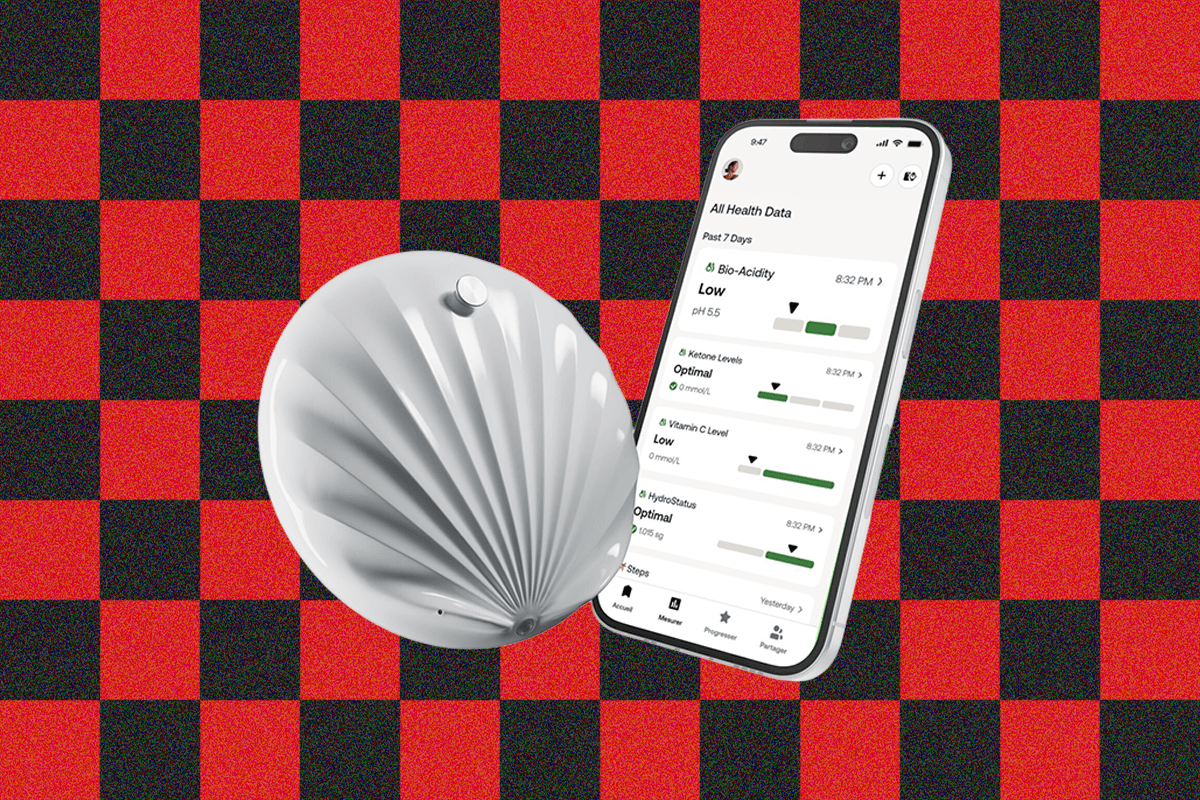All products featured on WIRED are independently selected by our editors. However, we may receive compensation from retailers and/or from purchases of products through these links. Learn more.
A few weeks ago, bathroom and plumbing company Kohler debuted the Dekoda, a health and wellness sensor that lives on your toilet bowl and records signs of your gut health and hydration. Now, Withings has launched the U-Scan. First shown at CES in 2023, the U-Scan also sits inside the toilet bowl. A thermal sensor detects when a fresh, er, sample is being deposited. The U-Scan takes a small sample and analyzes it on-site with miniature biochemical sensors inside an interchangeable cartridge.
There are two separate U-Scans. U-Scan Nutrio analyzes your diet, checking for biomarkers like bio-acidity, hydration status, and ketone levels, which shows that you’ve started burning body fat instead of sugar. U-Scan Calci also checks for calcium, which is a sign that you might have kidney stones. Results are then transmitted via Wi-Fi to the Withings app.
The cartridges are replaceable, and the sensor comes with a docking station to clean and recharge the sensor. Purchasing the U-Scan comes with a complimentary subscription to Withings+, the company’s upgraded app, which also includes a free consultation with a nutritionist.
The U-Scan packages start at $380, which comes with one U-Scan, either Nutrio or Calci, one cartridge, and two to four scans weekly (each cartridge lasts about 2.5 months). For more intensive monitoring, the Intensive package includes two cartridges for five to seven weekly measurements. Replacement cartridges are $100 for one cartridge or $180 for two, and Withings sends you the cartridge automatically depending on which package you select. The U-Scan is now available at Withings.com. We’ll be testing it soon. —Adrienne So
Samsung Brings Its Browser to Windows, and Teases a Trifold Phone
Samsung has long offered its own browser on its smartphones—Samsung Internet—but now the app is finally available on another platform: Windows. Considering Samsung makes Windows laptops and Android phones, this move allows folks who use the company’s browser to share their browsing history and bookmarks between phone and laptop, and if you have saved passwords with Samsung Pass, you can use it to autofill passwords on websites.
The company is taking this opportunity to bring some Galaxy AI features over as well, including Browsing Assist, which lets you instantly summarize webpages or translate them to another language. Samsung says its browser also blocks third-party web trackers, and there’s a Privacy Dashboard that lets you see what has been blocked.
Samsung Internet for PC is only available as a beta right now, but anyone in the US or South Korea on Windows 11 or Windows 10 (version 1809 and above) can download it now.
Samsung also quietly teased its long-awaited trifold smartphone (a folding phone that has three screens) at the Asia-Pacific Economic Cooperation (APEC) summit this week in South Korea. The device, which doesn’t have a name, was on display, but no one could touch it. Unlike the Huawei Mate XT, the phone’s screens fold outward like a book. Samsung told SamMobile it still plans to launch this smartphone in 2025, perhaps as early as next week, though it may be restricted to a few markets for now, such as China and Korea.
Insta360 Debuts a New 360 Camera

Courtesy of Insta360
Insta360 has released a smaller, lighter 360-degree camera, the X4 Air. The X4 Air is cheaper, too, though it lacks some features of the company’s flagship model, the Insta360 X5. Still, for casual consumers looking to get started in 360 video, the X4 Air’s $400 price makes it approachable.
Weighing 5.9 ounces (165 grams), the X4 Air is almost 2 ounces lighter than the X5. The body is also considerably smaller, making it easier to mount on helmets and other locations where weight and aerodynamics matter (a big reason why we like the GoPro Max 2 more than the Insta360 X5).
Like its larger cousin, the X5, the X4 Air is capable of 8K video, though it has smaller sensors and will likely deliver slightly lower quality video. The X5 uses a 1/1.28-inch sensor while the X4 Air uses a 1/1.8-inch sensor. Other differences include a less robust feature set. For example, the X4 Air lacks the 5.7K/60 fps Active HDR option of the X5, and as you would expect from a smaller body, battery life takes a hit; Insta360 is only claiming 88 minutes of 8K 30p footage versus the X5’s claimed 100 minutes. —Scott Gilbertson
Nothing’s Phone (3a) Lite is a Cheaper Option, but Only for the UK and Europe
%2520Lite%2520SOURCE%2520Simon%2520Hill.png)
Photograph: Simon Hill
Nothing’s phones have been a breath of fresh air in the design department, and the Nothing Phone (3) claimed a place in our Android phones guide because of its interesting aesthetic. Distinctly watered down in the specs and looks department (no circular Glyph Matrix display and just a single customizable LED on the back), the Nothing Phone (3a) Lite is a cheaper model aimed at the UK and Europe (it won’t arrive in the US).
Available in black or white, the Nothing Phone (3a) Lite has that trademark translucent back with a subtle red highlight and a retro font that extends into the pixelated user interface. It has a 6.77-inch, 120 Hz, OLED screen, with a MediaTek Dimensity 7300 Pro chipset, 8 GB of RAM, and a choice of 128 or 256 GB of storage, but there’s space for a microSD card on the flip side of the SIM tray. There’s a decent 5,000 mAh battery, but the phone only supports wired charging at 33 watts.
%2520Lite%2520SOURCE%2520Simon%2520Hill(1).png)
Photograph: Simon Hill
The camera can be a weak spot for budget phones, though we were quite impressed by the regular Nothing Phone (3a) and (3a) Pro. The (3a) Lite has a solid 50-megapixel main camera with a large-ish 1/1.57-inch sensor and an f/1.8 aperture, though it’s flanked by an 8-megapixel ultrawide and a macro lens, with a 16-megapixel shooter around front. IP54 water resistance, 5G, Wi-Fi 6, and Bluetooth 5.3 support round out the respectable specs.
Competitors abound in this price bracket, from Xiaomi’s Poco sub-brand to OnePlus, so Nothing is relying on its unique look and interesting software customizations to help it stand out. The Nothing Phone (3a) Lite is available now at £249 (249 euros) for the 128 GB model or £279 (279 euros) for the 256 GB. —Simon Hill

Courtesy OnePlus
The OnePlus 15 Gets a Launch Date
OnePlus has been slowly dripping news about its next flagship smartphone over the last month, and now we finally have an official announcement date: November 13. So far, we know the OnePlus 15 will be one of the first smartphones powered by Qualcomm’s next-gen Snapdragon 8 Elite 5 chipset. It likely moved up the launch of its smartphone (which was previously in January) to be among the first to launch with the new chip.
While OnePlus has officially ended its partnership with Hasselblad, it has been playing up a new image processing algorithm called DetailMax Engine to assure you that the cameras are still capable. Speaking of, there’s a new mode called Ultra-Clear 26MP, which lets you capture photos at 26 megapixels for a sharper image. The phone otherwise has a new look and comes in Infinite Black, Ultra Violet, and Sand Storm. The latter color is the only one with a micro-arc oxidized metal frame, which offers a “ceramic-grade coating” that OnePlus claims is 1.3x harder than titanium mid frame. OnePlus says it will share more details, including pricing and availability, on November 13 via a livestream on its YouTube channel.
So what happened to the OnePlus 14? The number four is superstitious in China as it’s similar to the word for death, so it’s common to see companies skip the “fourth” generation or even “14” and go to the next number.
Honda and BYD Have Very Different New Teeny Kei Cars

Courtesy of BYD; Honda
The Japan Mobility Show saw a raft of exciting new EVs being unveiled, but, for WIRED, smaller was most definitely better as Honda stole the limelight with the world premiere of its Super-ONE Prototype kei car, a ultracompact EV that will supposedly sound like a combustion hot hatch, complete with seven simulated gears to shift through via paddles on the steering wheel.
The Super-ONE is based on the regular Honda N-One, also an electric kei car, but here the tall and narrow stance is nicely offset by chunky wheel arches. Kei cars are limited to 64 horsepower but this version, destined for the Japanese and UK markets apparently, will likely get a power boost (to match the boost button on the steering wheel), when the production version arrives next year.
BYD has gone super small as well with its electric Racco, the brand’s very first kei car (also shown off at the the Japan Mobility Show.) This one, however, is most definitely not a wannabe hot hatch with its short hood, upright windshield, sliding doors, and near-vertical rear end rounding out the total length of 133.7 inches. Those dinky 15-inch alloy wheels all boast disc brakes, too, but the car itself is front-wheel drive.
The 20 kWh battery should be good for around 112 miles of WLTC range, and despite the small size the Racco is expected to be compatible with fast charging of up to 100 kW—all for about $16,500. —Jeremy White




